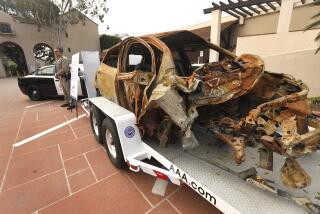Teens not sold on use of seat belts
- Share via
Next time you hand your teenagers the keys to the family vehicle, do some surveillance. Check to see whether they buckle their seat belts. You may be surprised to discover that when you aren’t present, or when they have friends in the vehicle, many don’t buckle up.
According to the National Highway Traffic Safety Administration, 5,341 people ages 15 to 20 were killed in motor vehicle crashes nationwide in 2001. And two-thirds of them were not using seat belts.
Teenage drivers have the highest fatality rate in motor vehicle crashes of any age group, and they also have a lower rate of buckling up than adults, according to a 2003 NHTSA study on teens and seat belts.
Even in California, which has about a 90% overall seat belt usage rate -- one of the highest in the country -- the rate for teens is not so high.
“It is a huge concern,” said Arline Dillman, traffic safety manager for the Automobile Club of Southern California.
Of teenagers killed in vehicle crashes in California in 2000, 72% weren’t wearing seat belts.
“Teens are a particular problem because their crash rates are the highest of any age group,” Dillman said.
“When you couple that with not wearing a seat belt, it’s really a recipe for disaster.”
Young, inexperienced drivers may “frequently engage in high-risk behaviors, such as speeding and/or driving after using alcohol or drugs,” according to this year’s NHTSA report.
California’s high overall rate of seat belt use is credited largely to the state’s so-called primary seat law, which allows law enforcement officers to ticket violators for not buckling up.
States with weaker, secondary seat belt laws allow officers to ticket seat belt violators only if the vehicle has been stopped for another alleged violation
Safety advocates are pushing for more states to pass tougher laws.
Allan Williams, chief scientist at the Insurance Institute for Highway Safety, said teens would take the issue more seriously, for example, if seat belt requirements were added to the graduated licensing process.
But opponents of strict seat belt laws argue that people have a personal right to refuse to wear them because the decision does not affect others.
Carol J. Carmody, a member of the National Transportation Safety Board, disagrees: “Motor vehicle injuries and fatalities have a significant societal cost,” she told Illinois state officials in an address this year. NHTSA reported that the deaths and injuries from not using safety belts result in about $26 billion in economic costs annually.
Why do teenagers resist wearing seat belts?
“They feel invincible, like nothing is going to happen to them,” Dillman said. “Teens can be big risk takers. Some teens don’t think it is cool to be seen wearing a seat belt.”
Indeed, peer pressure and embarrassment were among the top reasons high school students listed in a poll conducted recently by Volkswagen of America.
Parental attitudes also can affect whether teens buckle up. Statistics indicate that about 25% of motor vehicle occupants nationwide, including adults, don’t use seat belts.
The Insurance Institute for Highway Safety studied high school pupils’ behavior last year at 12 schools in Connecticut and Massachusetts and found that even when adults were driving and wearing their seat belts, only 50% of male teen passengers and 56% of young female passengers in the vehicles buckled up.
“It’s remarkable that so many parents who make the effort to protect themselves by buckling up in passenger vehicles aren’t insisting that their sons and daughters do the same thing,” said Williams of the insurance institute. “Parents need to do more to get their teenagers to use belts.”
*
Write to Jeanne Wright in care of Your Wheels, Business Section, Los Angeles Times, 202 W. 1st St., Los Angeles, CA 90012. E-mail: jeanrite@aol.com.






